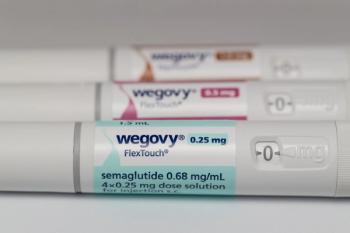
Gene Test Predicts Risk of Cirrhosis in Chronic Hepatitis C
ALAMEDA, Calif. -- In patients with chronic hepatitis C, a seven-gene test may outdo usual clinical risk factors in predicting the likelihood of advance to cirrhosis.
ALAMEDA, Calif., April 27 -- For patients with chronic hepatitis C, a seven-gene signature may outdo usual clinical risk factors in predicting the likelihood of advance to cirrhosis.
In a validation study of 154 HCV patients to confirm the reliability of the so-called Cirrhosis Risk Score, the seven-gene test was better at distinguishing high-risk from low-risk patients, compared with standard clinical risk factors, such as alcohol use, according to an online report scheduled for the August issue of Hepatology.
The test is needed, said Hongjin Huang, Ph.D., of Celera Diagnostics here, Ramsey C. Cheung, M.D., of Stanford, and colleagues, because the natural history of chronic HCV infection is highly variable, and costly antiviral therapy, with its side-effects, has an overall response rate of only about 50%.
"This test is the first of its kind to use the genetic makeup of each patient to determine who is likely to develop cirrhosis," said Dr. Cheung, a paid consultant for Celera, which also funded the study.
"This test allows both physicians and patients to make an intelligent decision about the urgency of beginning antiviral therapy," Dr. Cheung said. "If a patient turns out to be low-risk, we might advise the patient to consider deferring treatment, avoiding unnecessary side effects and expense of current therapy."
Because of the lack of prognostic tests, current recommendations advise a long, expensive course of antiviral therapy for patients who have a liver biopsy showing portal or bridging-fibrosis, and at least moderate inflammation and necrosis.
However, this approach cannot predict cirrhosis in those with less severe histology. Furthermore, a liver biopsy represents only one point in time, whereas genetic markers are life-long, the researchers wrote.
Standard clinical risk factors for rapid progression to cirrhosis, which include age, gender, alcohol use, age at infection, obesity, and hepatic steatosis, are not sufficiently accurate to identify high-risk patients, due to individual variability, the researchers said.
Dr. Huang and her colleagues at Celera developed the cirrhosis test scanning the DNA of more than 1,000 patients. Of 25,000 genetic variants tested, they found seven that could be used as a prediction "signature."
In this study, the researchers first identified all significant markers from a genome scan in the so-called training cohort (N=420), and selected 361 markers for the signature. Next, they developed a signature consisting of markers most predictive for cirrhosis risk in Caucasian patients, a group with an adequate number of patients.
The seven-gene Cirrhosis Risk Score, as it is called, was then used to estimate the risk of developing cirrhosis for each patient. The area-under-the-ROC curves (AUC) for the cirrhosis risk score was 0.75 in this training cohort, the researchers reported.
Next, the risk score was tested in an independently enrolled validation cohort of 154 patients at three different medical centers. A risk signature consisting of seven markers was used for each of these patients.
In the validation cohort, AUC was only 0.53 when standard clinical factors were used to determine risk, but increased to 0.73 with the Cirrhosis Risk Score, and to 0.76 when the gene-signature test and and clinical risk factors were combined, the researchers reported.
It is worth noting, the researchers said, that the AUC in the validation set was nearly identical to that developed in the training set (0.73 versus 0.75).
For the gene test, a cutoff of less than 0.50 to identify low-risk patients would misclassify only 10.3% of high-risk patients, while a high cutoff of more than 0.70 to identify high-risk patients would misclassify 22.3% of low-risk patients, the researchers said.
It is important to emphasize, the researchers wrote, that the entire process of building the gene signature, including selecting source single nucleotide polymorphisms (SNPs), ranking them, and building the final signature, was done strictly within the training cohort. The validation cohort was used only to test the final gene signature once it was established.
Given the results of the training and validation sets, the test would be applicable to other independent sample sets, and the signature-building approach described here might be generalized to build predictive signatures in other diseases, the researchers said.
However, they added, prospective studies should be conducted to further validate these findings.
In discussing the study's limitations, the researchers said that ideally the study should have been longitudinal with serial biopsies from all patients, although that would not have been practical. Biopsies should have been scored by a single pathologist, although that, too, was not possible. Also, they said, the gene signature needs to be validated and tested in non-Caucasian populations.
The use of this test in clinical practice could help reduce the rate of liver biopsies in patients such as these, the researchers said. In addition, the test might complement the current and evolving non-invasive fibrosis-staging tests, by adding the much needed dimension of risk assessment to the management of chronic hepatitis C. However, prospective validation of this practice would be needed, the researchers said.
In June 2006, Celera licensed the Specialty Laboratories of Valencia, Calif., to perform the genetic test, which currently costs about .
Newsletter
Enhance your clinical practice with the Patient Care newsletter, offering the latest evidence-based guidelines, diagnostic insights, and treatment strategies for primary care physicians.


























































































































































































































































































